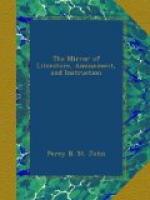[Illustration: (The Chlamyphorus.)]
The dimensions of the specimen in the Museum are as follow: length from tip of nose to root of tail, 5-1/2 inches; ditto tail, 1-1/4 in.; height at shoulder, 1-3/4 in. A more detailed account of the internal structure and economy of this extraordinary little animal will be found in the Zoological Journal, vols. ii. and iii.
* * * * *
ARROW ROOT.
[Mr. Andrew Mathews, of Lima, has communicated to the Gardeners’ Magazine the following account of the Otaheitan method of preparing the excellent farinaceous substance termed Arrow Root, so extensively used in this country.]
The root (Tacca pinnatifida Lin., the Pea of the natives) grows in the greatest abundance in all the islands which we visited; viz., in Otaheite, Eimeo, Huaheine, Raiatea, and Otaha. Its favourite situation is on the sides and ridges of the hills which rise directly from the sea, and which are generally covered with a coarse grass, on a red sandy loam. The root is round, white, smooth, full of eyes like a potato, and from 2 to 3 in. in diameter. The flower-stem rises directly from the root, simple; from 2 to 4 ft. in height, as thick as a man’s finger, bearing its flowers in a loose simple umbel on the summit; and, when large and full blown, it presents a beautiful and delicate appearance. The leaf is large, tri-pinnatifid, segments acute, of a rich shining green: it is subject to great variation in the size of the segments, some leaves being much more cut, and having the segments narrower, than others. When a sufficient quantity of the roots is collected, they are taken to a running stream, or to the sea-beach, and washed; the outer skin is carefully scraped off at the same time with a shell; and those who are particular in the preparation scrape out even the eyes. The root is then reduced to a pulp, by rubbing it up and down a kind of rasp, made as follows:—A piece of board, about 3 in. wide, and 12 ft. long, is procured, upon which some coarse twine, made of the fibres of the cocoa nut husk, is tightly and regularly wound, and which affords an admirable substitute for a coarse rasp. The pulp, when prepared, is washed first with salt or sea water, through a sieve made of the fibrous web which protects the young frond of the cocoa-nut palm; and the starch, or arrow-root, being carried through with the water, is received in a wooden trough made like the small canoes used by the natives. The starch is allowed to settle for a few days; the water is then strained, or, more properly, poured off, and the sediment rewashed with fresh (or river) water. This washing is repeated three times with spring water; after which the deposit is made into balls of about 7 or 8 in. in diameter, and in this state dried in the sun for twelve or twenty-four hours. The balls are then broken, and the powder spread for some




